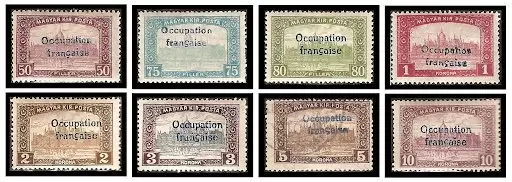Hungary before and after Trianon
The post-World War I period in Hungarian philatelic history, particularly between 1918 and 1920, is characterized by complex events and shifting geographic borders, culminating in the signing of the Treaty of Trianon in 1920. This era is reflected in the philatelic issues of Hungary, which feature overprinting of stamps to signify changing political and geographic circumstances.
Occupation stamps were issued by the political authorities of occupying countries such as Romania, Serbia, and France, as well as by municipal authorities within Hungary. Successor state issues, overprinted by Czechoslovakia, Yugoslavia, Romania, Austria, and Fiume (Italy), also emerged during this period.
The Treaty of Trianon, which ceded 70% of Hungary’s territory to other countries, resulted in a significant portion of Hungary’s population becoming minorities in the successor states. This event is considered a devastating tragedy in Hungarian history, as large parts of the country, including areas inhabited by ethnic Magyars, were given to Romania, Yugoslavia, Czechoslovakia, Italy, Austria, and Poland.
During the occupation period, stamps of Hungary were overprinted to reflect the authorities controlling the territory, meeting territorial postal needs. These overprinted stamps became highly sought after by stamp collectors, leading to rapid sellouts and speculation that caused their values to skyrocket. Limited printings and high demand led to widespread forgery of these stamps.
Additionally, local stamps were issued by municipal authorities throughout Hungary during this time, while successor states also issued stamps for the territories they annexed from Hungary. Overall, this period represents a complex and tumultuous time in Hungarian philatelic history, marked by political upheaval and territorial changes reflected in stamp issues.
Occupation stamps: There were 10 series of occupation stamps issued which document this chapter in the history of Hungary. The categories and their occupiers as listed in the Scott catalog are:
1N – France – Arad region occupied by French military forces
2N – Romania – first issue of Debrecen occupied by Romanian military
3N – Romania – second issue of Debrecen occupied by Romanian military
4N – Romania – Temesvar region, which followed the Serbian occupation
5N – Romania – first Transylvania issued for town of Kolozsvar
6N – Romania – second Transylvania issued for town of Nagyvarad
7N – Serbia – first Baranya occupied by Serb military
8N – Serbia – second Baranya occupied by Serb military
9N – Serbia – Temesvar, this was the first occupation of Temesvar
10N – Serbia – Banat, Bacska, this was actually a locally initiated issue between the Serbian and Romanian occupations of Temesvar.
The Temesvár territory, situated in the southern part of Hungary between Yugoslavia and Romania, underwent various changes during the post-World War I period. Originally occupied by Serbia, it was then governed by local forces while still under Serbian control, and later occupied by Romania. The Serbian forces took much of the money and machinery from Temesvár upon their retreat, prompting the Romanian forces to pay their troops with occupation stamps.
Szeged, the location of the Hungarian National Government, which opposed the central Soviet government in Budapest, issued overprinted stamps with the inscription “Hungarian National Government” (Magyar Nemzeti Kormány).
Successor states, including Czechoslovakia, Yugoslavia, and Fiume, took over Hungarian territories and overprinted Hungarian stamps in local post offices as their first issues. Czechoslovakian stamps also served the additional function of raising money for war relief through a surcharge to the postal rate, making them semi-postal stamps.
Local issues, distinct from occupation issues, involved overprinting by local or municipal authorities for use within their municipality. Examples include Zombor, Ada, Nagyszeben, Kluj, Pancsova, Perlak, Baranya III, Skalica, Lajtabansag (Western Hungary), and others. Lajtabansag issued several series of stamps between 1918 and 1921.
Forgery of occupation stamps was extensive, with numerous reference books documenting both forgeries and genuine issues. Characteristics of genuine overprints can be distinguished by expertization marks placed on the back by various expertizers, although some forgers also expertized their forgeries. Notable forgers include “PAPE,” whose mark on the back of a stamp indicates a forgery. Reference materials such as the “Magyar Posta- és Illetekbelyeg Katalogus,” Chris Brainard’s catalog, and Csaba Kohalmi’s monograph provide valuable insights into this period of Hungarian philatelic history.

